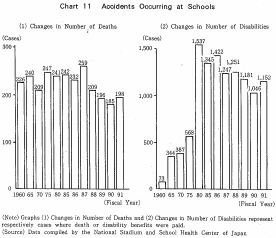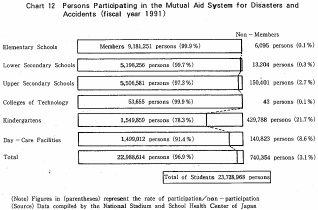| Home > Policy > White Paper, Notice, Announcement > White Paper > JAPANESE GOVERNMENT POLICIES IN EDUCATION,SCIENCE AND CULTURE1991 > PART |
||
Cultivating habits needed for a safe, healthy and happy life and for harmonious physical and mental development has become an important goal of school education. For this reason, it is vital that children acquire the knowledge for leading a safe life and receive instruction in developing the proper skills and attitudes for safe conduct. More specifically it is important to have school children: understand what causes accidents, discover where danger is concealed in the course of everyday life, make the right decisions, cope properly, and develop the skills required for taking the appropriate course of action during accidents and disasters.
Because there are still a considerable number of accidents that
occur at school and because significant numbers of school children are killed
in traffic accidents, the importance of safety instruction at schools is becoming
even greater.
Looking at longitudinal changes in numbers of accidents occurring among school children while under school jurisdiction, an annual increase can be seen in the number of injury and disease cases; however, these statistics show a leveling off trend for the period after 1985. The number of deaths has continued to range between 200 and 300 cases yearly although a decreasing trend can be seen after 1988. Disability and injury cases rose sharply after 1975, then after 3 peak in 1981 began a decreasing trend.

Regarding the circumstances accompanying death, an examination of the causes of death reveals that 60% of these were sudden deaths such as sudden heart failure, followed by head injuries with 15%. Regarding the situation for type of injuries, tooth injury accounted for 46%, followed by eye injuries with 16%.
A classification of the circumstances accompanying injuries
by school level shows that most injuries occurring to elementary school children
happen during rest periods, while for lower and upper secondary school the occurrence
is highest during instruction in outdoor activities.
An examination of the total number of on-the-road traffic fatalities
in 1970 shows there were 16,765 victims. After that year, the numbers began to
decrease and by 1979 fatalities dropped to 8,466. In recent years, however, a
growth trend has occurred with 11,105 deaths in 1991. Moreover, in the period
since 1988, the number of deaths has gone over the 10,000 mark for four consecutive
years; in fact, the period has become known as the "second traffic war" following
the "first traffic war," which occurred around 1970. The early period of 1992
(up to the end of April) shows a 10% increase over the identical period from
the previous year. This is the worst increase for this period since 1974. In
the midst of these statistics, traffic deaths among elementary and lower secondary
school students reveal a general decreasing trend. For 1991, 171 deaths were
recorded for elementary school children, and 72 deaths for lower secondary school
students. In contrast, however, as in previous years, deaths among upper secondary
school students for 1991 remained significantly high at 483, out of which approximately
70% occurred on motorbikes.
To contribute to the improvement and enrichment of school safety
education, the Ministry has compiled a "Handbook for Elementary School Safety
Guidance" (revised in 1983) and a "Handbook for Lower Secondary School Safety
Guidance" (revised in 1984). These handbooks were created to make the purpose
of safety instruction thoroughly understood and the Ministry continues to update
them based on the revised Courses of Study. The Ministry also organizes training
seminars and research/study discussion meetings such as the "Training Course
for Traffic Safety Education Instructors" (both central and prefectural training
seminars) for teachers responsible for safety education. Through these training
sessions and study meetings, teachers are provided with opportunities for training
in instructional planning and effective teaching methods which help improve teaching
skills and develop teaching materials.
As a part of safety education, traffic safety education is taught principally through special education activities including classroom and homeroom activities, school events and other activities. It aims to help children to develop into well-rounded citizens with an awareness of being responsible members of a "mobile society," who endeavor to improve their own safety consciousness and driving etiquette, and who are concerned not only with their own safety but with the safety of others and the society at large as well.
The Ministry is enriching and increasing items regarding traffic
safety in the subject of "health and physical education" at lower and upper secondary
schools through revision in the Courses of Study. The Ministry is carrying out
projects for traffic safety education promotion communities which bring together
schools, families and the community to deal with traffic safety. It also holds
a "Traffic Safety Education Leaders Course," offering practical motorbike riding
skill guidance for teachers and other related personnel. Furthermore, the Japan
Association for the Spread of Traffic Safety Education" was commissioned to carry
out investigative studies on traffic safety. On the basis of these findings,
the following handbooks and other materials were drawn up or revised, and distributed,
thus contributing to the promotion of traffic safety education and the prevention
of traffic accidents involving school children: "Handbook for Upper Secondary
School Traffic Safety Guidance" (revised in 1988), "Handbook for Bicycle Safety
Guidance" (revised in 1985), "Handbook for Upper Secondary School Extracurricular
Traffic Safety Guidance" (revised in 1987), and "Handbook for Motorbike Safety
Guidance at Upper Secondary Schools" (newly compiled in 1988).
Motorbike accidents involving upper secondary school students have become a serious problem, especially since the period after 1965. In line with the community situation and as a practical response to the problem, the so-called "THREE DON'T" movement was started in the 1970's by schools and communities. The "THREE DON'Ts" stand for "don't get a driver's license," "don't buy a motorbike," and "don't ride a motorbike."
Regardless of the existence of this kind of movement, the Ministry is providing guidance through various types of study seminars to teach traffic safety education in a systematic way at every upper secondary school. Also, along with the implementation of the Third Basic Plan for Traffic Safety (1981-1985), in June of 1981 a circular was issued from the Director-General of the Bureau of Physical Education and Sports entitled, "Guaranteeing Traffic Safety and Thorough Traffic Safety Education." Furthermore, with reference to the July 1989 decision from the Head Office for Traffic Policy on "Comprehensive Measures for Motorbike Accident Prevention," the Ministry is providing guidance for safe driving, etc., in accordance with local conditions and the situation of students, enlisting the cooperation of organizations and associations promoting safe motorbike operation. This kind of guidance serves to raise consciousness concerning safe driving, and improves practical skills. Under these policies, schools and communities have started to examine comprehensive strategies for prevention of motorbike accidents according to their respective situations.
In addition, since 1990 the Ministry has carried out an "Investigative
Study on Instructional Methods for Upper Secondary School Students Who Ride Motorbikes." that
examines effective methods of traffic safety education including instruction
of' practical skills as part of school educational activities.
The necessity for citizens to fully comprehend the knowledge
and skills for performing first aid in the case of injury and sudden illness
has been pointed out from many quarters, especially in light of the recent rise
in traffic accidents, heart failure and other factors contributing to the growing
problem of sudden deaths. Thus, the revised Course of Study for Upper Secondary
Schools included "first aid" as an item to be taught in the subject of "health
education." In a related activity, during the three year period until the revised
Courses of Study are fully enforced (1991-1993), all teachers in charge of "health
and physical education" at public upper secondary schools are required to attend
practical seminars under the "Project for Emergency First Aid Seminars." These
seminars have been providing training in cardio-pulmonary resuscitation and other
first aid skills since 1991.
Disasters occur in many forms. Natural disasters include typhoons, heavy rains, heavy snowfall, floods, flood tides, earthquakes, tsunamis and volcanic eruptions. Man-made disasters include fires, gas explosions, etc. Due to its geographical location and geomorphic conditions, etc., Japan is known for being a country susceptible to natural disasters such as earthquakes, typhoons and volcanic eruptions. This makes disaster prevention education here an absolute necessity.
Disaster prevention is defined in the Disaster Countermeasures Basic Law (enacted in 1961) as preventing disasters before they occur, preventing the spread of damage, and repairing damage when it occurs. As for policy regarding disasters, there are so-called "hard" measures such as improvements in facilities and equipment, building evacuation places, paths, roads. etc., and "soft" measures including carrying out evacuation drills and setting down plans for disaster prevention. Disaster policy should be comprehensive and promoted from both angles.
Especially in the case of schools (which accommodate large numbers of school children in various stages of mental and physical growth and development), it is important that efforts are always made to maintain and inspect evacuation facilities and to ensure that children can smoothly and quickly evacuate in the occurrence of a disaster.
For some time, emergency safety instruction at schools has aimed
to "help children understand what is the safe course of action to take during
earthquakes and other emergency situations and train them to take a safe course
of action according to the situation." Instruction is carried out in a systematic
and organized manner throughout the entire range of school activities, principally
through school events and class activities including the carrying out of evacuation
drills.
The Mutual Aid System for Disasters and Accidents based on a joint contract between the National Stadium and School Health Center of Japan and school establishing bodies, provides compensation to the parents or guardians of school children in the case of disasters and accidents occurring under school jurisdiction. Benefits include medical treatment benefits, disability benefits, and death benefits. This system contributes to the smoother operation of school education
Following a major revision in 1978, the standards for benefits have undergone a series of improvements. Death benefits as of 1986 were 14,000,000 yen and the highest level of disability benefits was 18,900,000 yen in 1988. Moreover, as of 1992 death benefits were raised (from 14,000,000 yen to 17,000,000 yen) with disability benefits for the same year going up as well (first level benefits from 18,900,000 to 22,900,000; fourteenth level benefits from 400,000 to 490,000).

The National Stadium and School Health Center of Japan is designating pilot schools for studies on school safety in each prefecture. The Center also designates a number of municipalities to serve as traffic safety education promotional communities. Under this project, working together with families and communities, and with cooperation from associations and related institutions, the Center is actively promoting the establishment of safer road and traffic environments, and raising the safety consciousness and practical safety skills of school children.
| Back to Top | MEXT HOME |